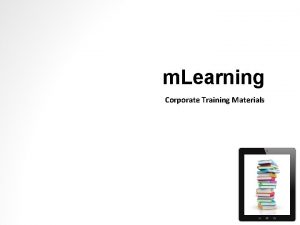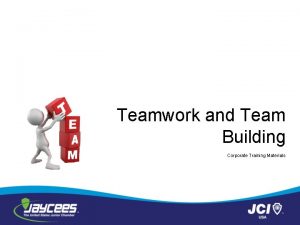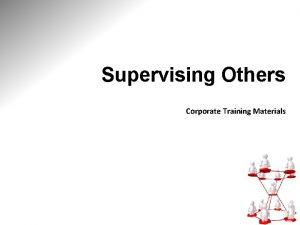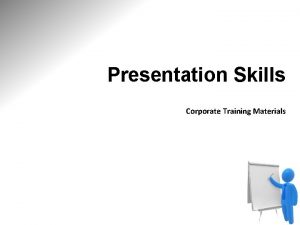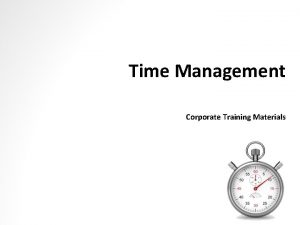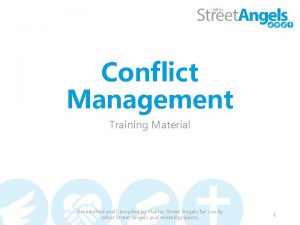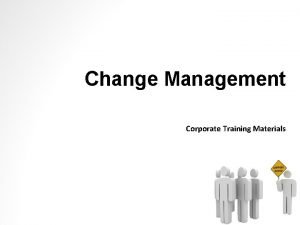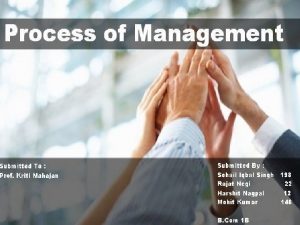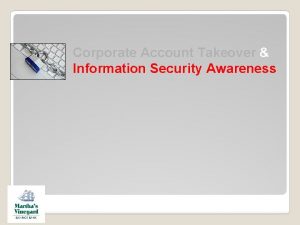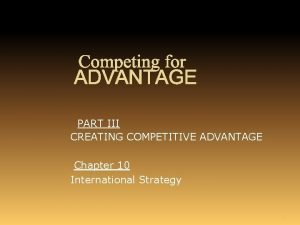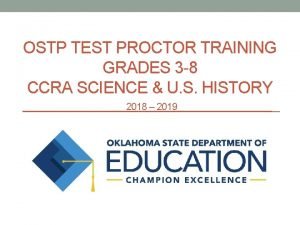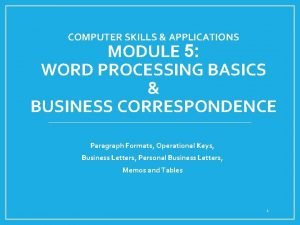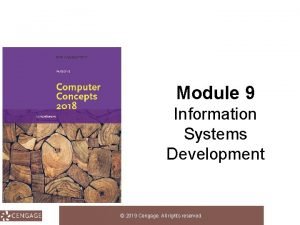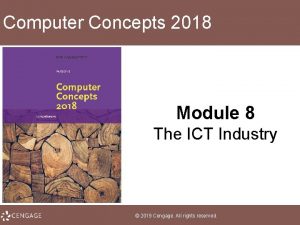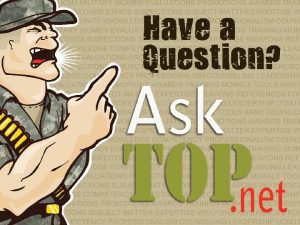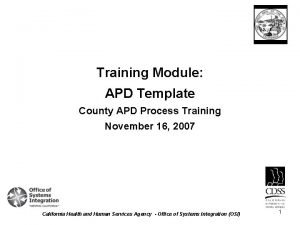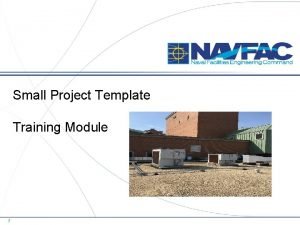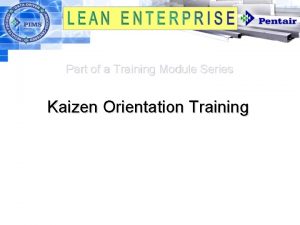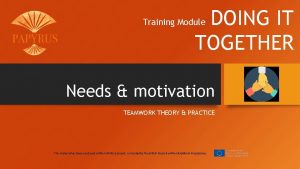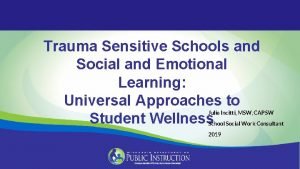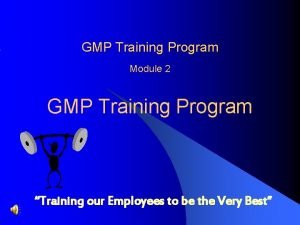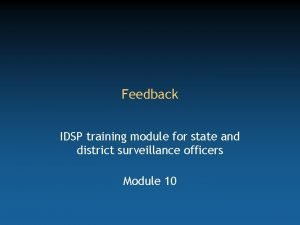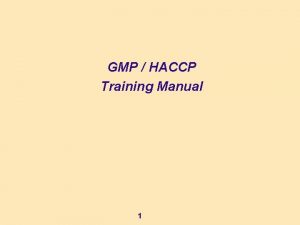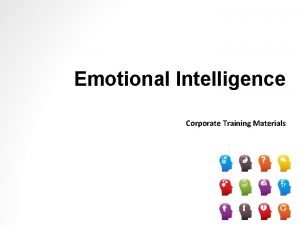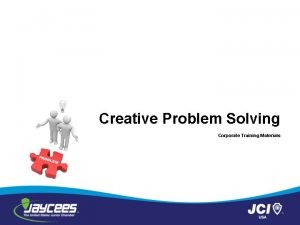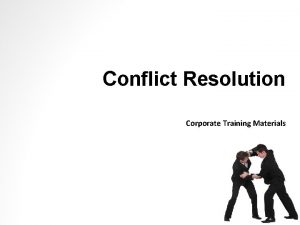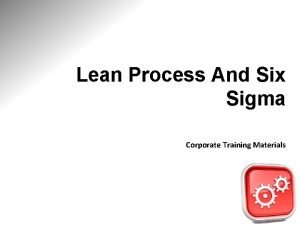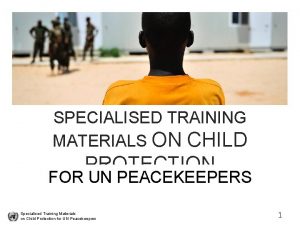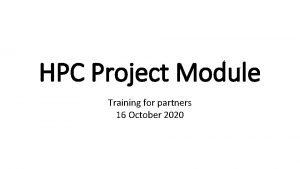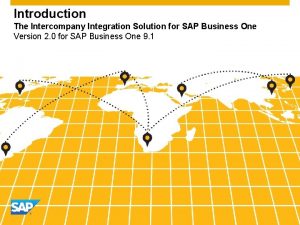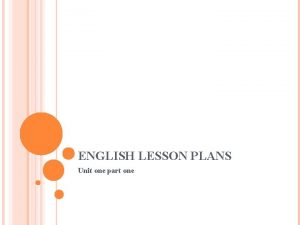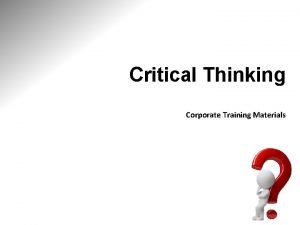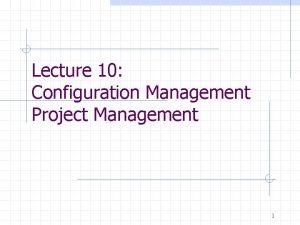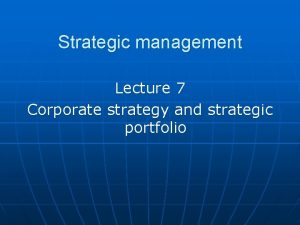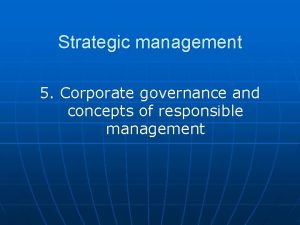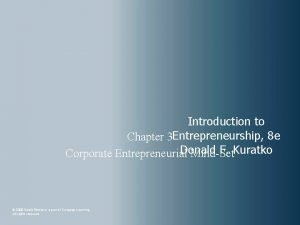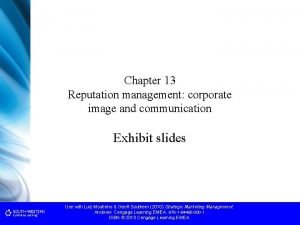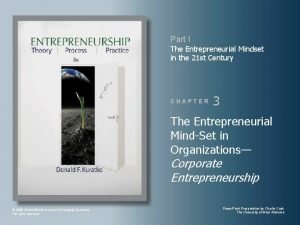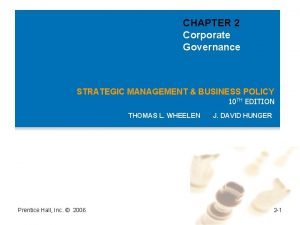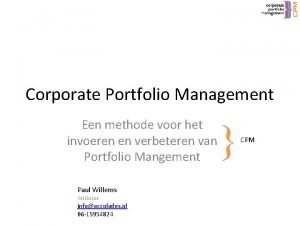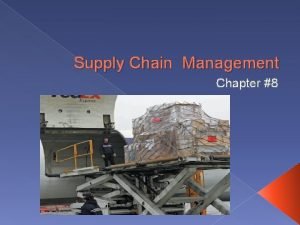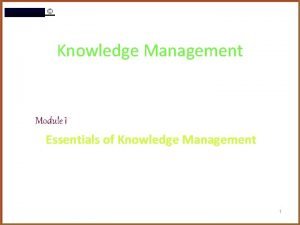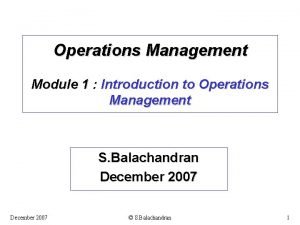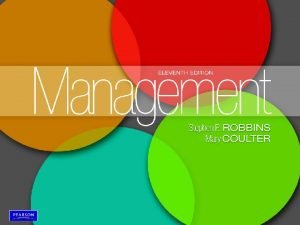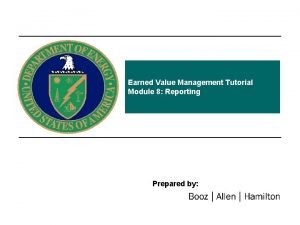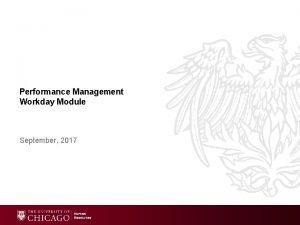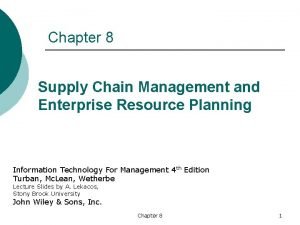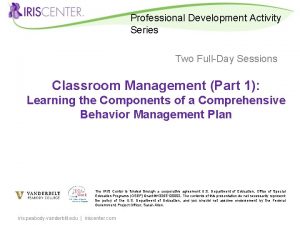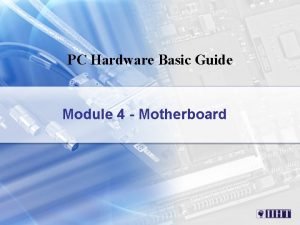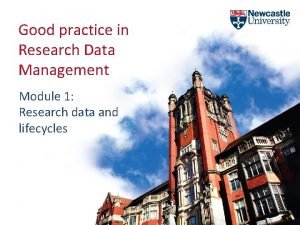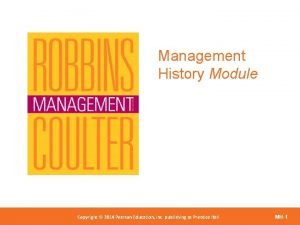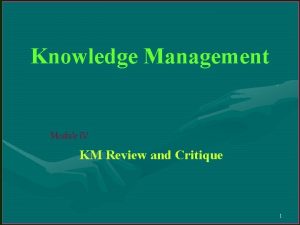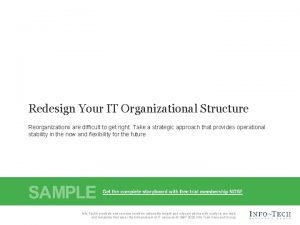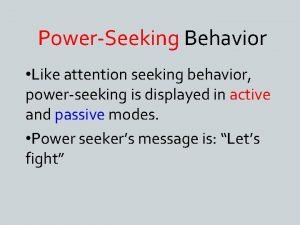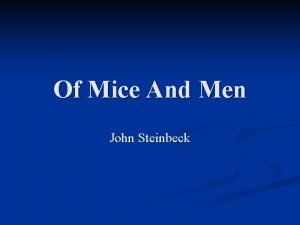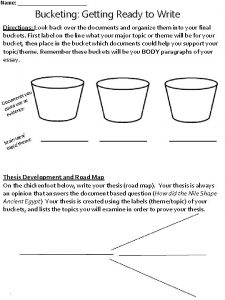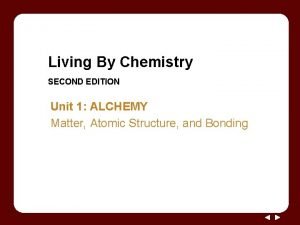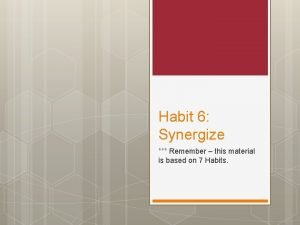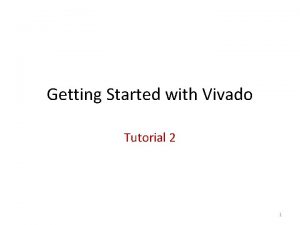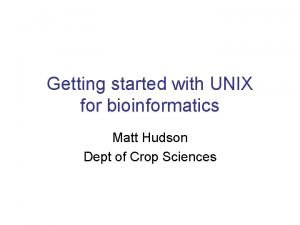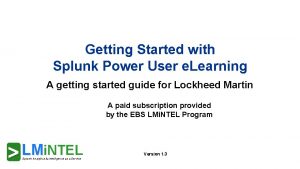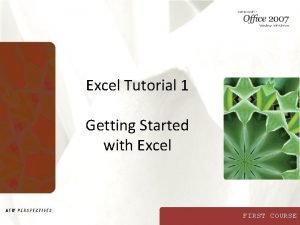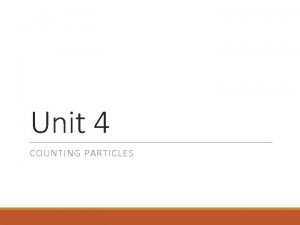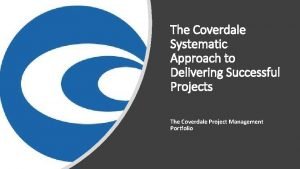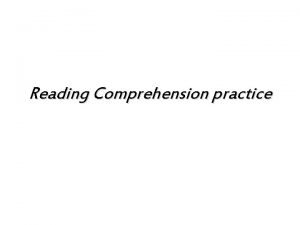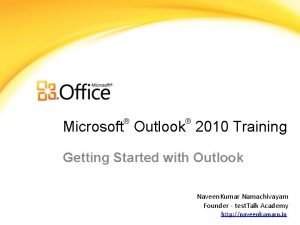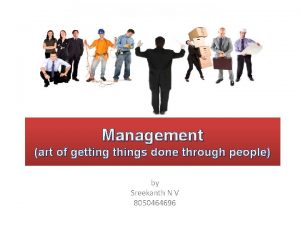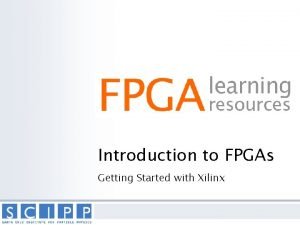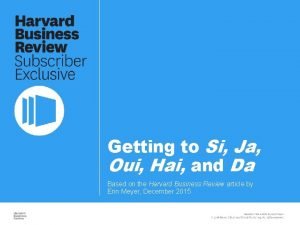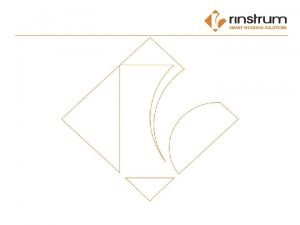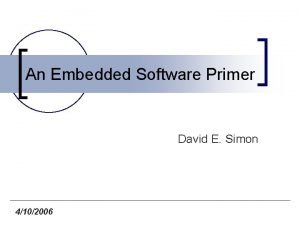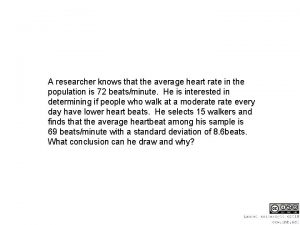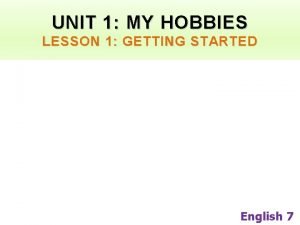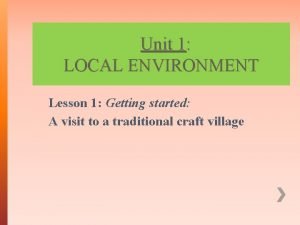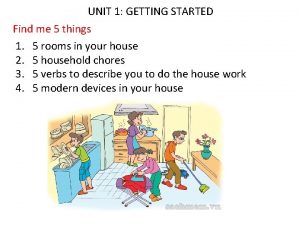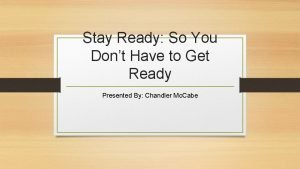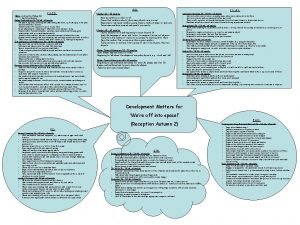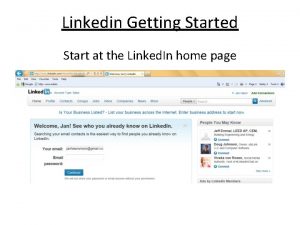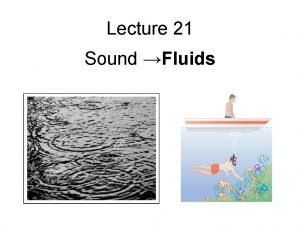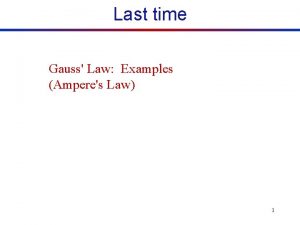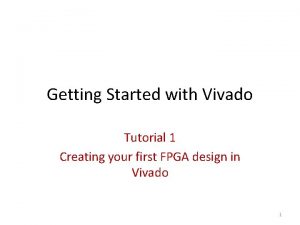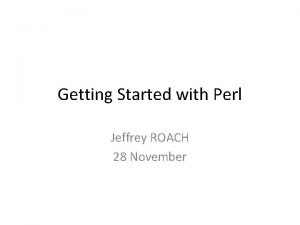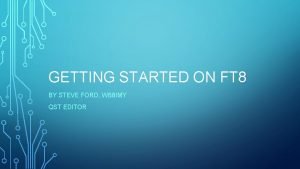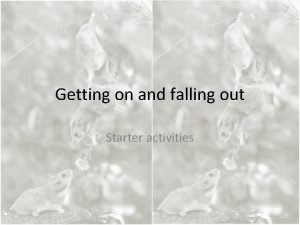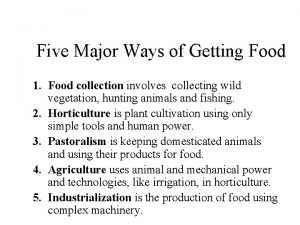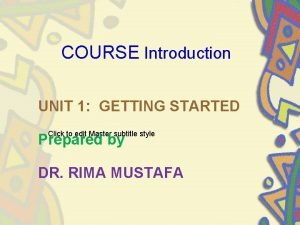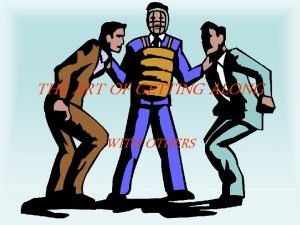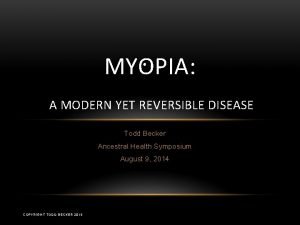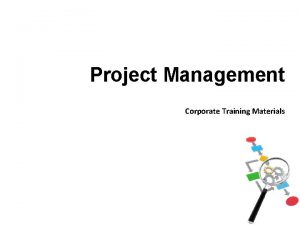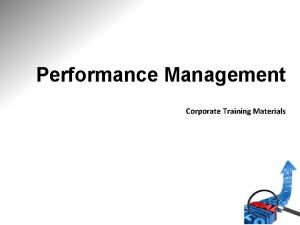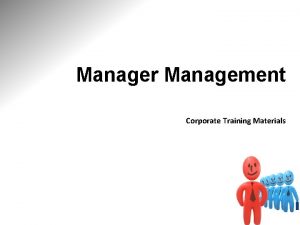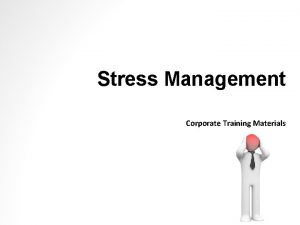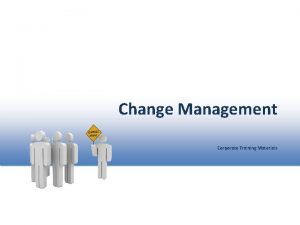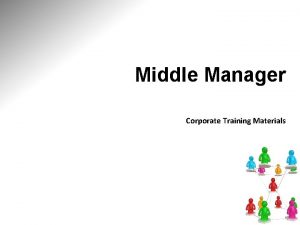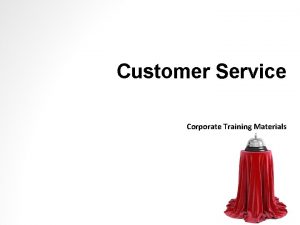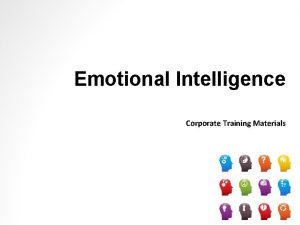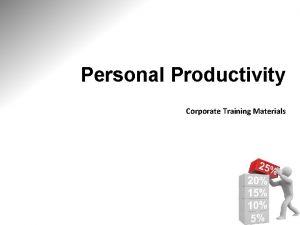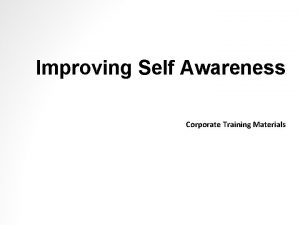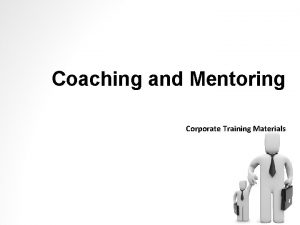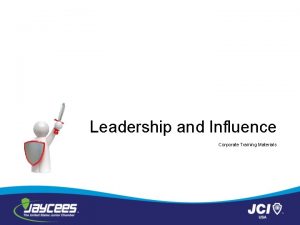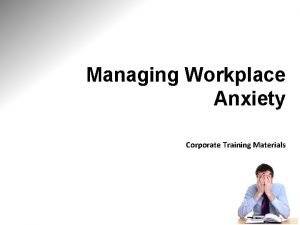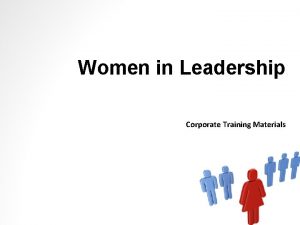Project Management Corporate Training Materials Module One Getting


























































































































































- Slides: 154

Project Management Corporate Training Materials

Module One: Getting Started In the past few decades, organizations have discovered something incredible: principles that have been used to create enormous successes in large projects can be applied to projects of any size to create amazing success. As a result, many employees are expected to understand project management techniques and how to apply them to projects of any size. It must be considered that there is nothing more difficult to carry out nor more doubtful of success nor more dangerous to handle than to initiate a new order of things. Machiavelli

Workshop Objectives Define projects Project needs assessment Project schedule Planning tools

Module Two: Key Concepts (I) Before we get started, let’s make sure we all understand just what we mean by a project and by project management. We’ll also look at what a project manager’s role is. Do not repeat the tactics which have gained you one victory, but let your methods be regulated by the infinite variety of circumstances. Sun Tzu

What is a Project? Limited endeavor Start and end date Clear goals Defined responsibility

What is a Project Management? Planning and organizing Managing resources Within budget

What is Project Manager? Responsible and accountable Setting objectives Balance wants and needs

Module Two: Review Questions 1. What is the definition of a project? a) A planned series of future events, items, or performances. b) A meeting of people face to face, especially for consultation. c) A limited endeavor that is undertaken to meet particular goals and objectives. d) An assembly of people, especially the members of a society or committee, for discussion or entertainment. 2. What is an example of a characteristic of a successful project? a) b) c) d) Defined ownership and responsibility Vague goals A timeline that changes frequently Methodology that is “plan-as-you-go”

Module Two: Review Questions 3. What is not an example of a characteristic of a successful project? a) b) c) d) Ambiguous communication Dedicated team Completion evaluated based on original plan Supported by an organization’s management team 4. What can be defined as “the combined art and science of planning, organizing, and managing resources to get a particular project done on time, within budget, and with the results that the organization set out to achieve”? a) b) c) d) Meeting planning Project planning Office management Project management

Module Two: Review Questions 5. Which of these statements is true of project management? a) Project management involves repetitive, permanent, or semi-permanent functional activities to produce products or services. b) Project management is just like meeting management, involving a chairperson, minute taker, and attendee participation. c) There are many types of project management designed for different scenarios and different industries. d) There is only one trusted method for project management, and that method is the traditional method. 6. What is the definition of a project manager? a) The profession involving office supervisory positions. b) The person responsible and accountable for accomplishing the stated project objectives. c) The person ultimately responsible for the day-to-day operations or an organization. d) The person who presides over a meeting, committee, or board.

Module Two: Review Questions 7. What is not an example of a key project management responsibility? a) b) c) d) Organizing the office before the project begins Deconstructing the project requirements Managing the triple constraint for projects All of the above 8. What job is the project manager often required to do? a) Balancing what the customer wants, and needs with what the team can provide in a particular time frame and with a particular budget. b) Focusing on consistent and permanent projects that the company needs on a rolling basis. c) Giving a brief explanation of the purpose of the meeting and an idea of what you are looking for in terms of topics. d) Maintains focus while writing down information during the project’s many meetings.

Module Two: Review Questions 9. Which of these is not a key skill of a project manager? a) b) c) d) Excellent at taking orders from the team Negotiation Leadership Stress and anger management 10. Which of these statement is true of project management? a) A successful project manager has a basic skill set and is focused on application of these skills, not on learning new ones. b) A project manager is the person who delegates responsibility for accomplishing the stated project objectives. c) There is only one type of project management, designed for specific scenarios and specific industries. d) One can find uses for most of the project management tools that are discussed in day-to-day life, both personal and professional.

Module Two: Review Questions 1. What is the definition of a project? a) A planned series of future events, items, or performances. b) A meeting of people face to face, especially for consultation. c) A limited endeavor that is undertaken to meet particular goals and objectives. d) An assembly of people, especially the members of a society or committee, for discussion or entertainment. 2. What is an example of a characteristic of a successful project? a) b) c) d) Defined ownership and responsibility Vague goals A timeline that changes frequently Methodology that is “plan-as-you-go”

Module Two: Review Questions 3. What is not an example of a characteristic of a successful project? a) b) c) d) Ambiguous communication Dedicated team Completion evaluated based on original plan Supported by an organization’s management team 4. What can be defined as “the combined art and science of planning, organizing, and managing resources to get a particular project done on time, within budget, and with the results that the organization set out to achieve”? a) b) c) d) Meeting planning Project planning Office management Project management

Module Two: Review Questions 5. Which of these statements is true of project management? a) Project management involves repetitive, permanent, or semi-permanent functional activities to produce products or services. b) Project management is just like meeting management, involving a chairperson, minute taker, and attendee participation. c) There are many types of project management designed for different scenarios and different industries. d) There is only one trusted method for project management, and that method is the traditional method. 6. What is the definition of a project manager? a) The profession involving office supervisory positions. b) The person responsible and accountable for accomplishing the stated project objectives. c) The person ultimately responsible for the day-to-day operations or an organization. d) The person who presides over a meeting, committee, or board.

Module Two: Review Questions 7. What is not an example of a key project management responsibility? a) b) c) d) Organizing the office before the project begins Deconstructing the project requirements Managing the triple constraint for projects All of the above 8. What job is the project manager often required to do? a) Balancing what the customer wants, and needs with what the team can provide in a particular time frame and with a particular budget. b) Focusing on consistent and permanent projects that the company needs on a rolling basis. c) Giving a brief explanation of the purpose of the meeting and an idea of what you are looking for in terms of topics. d) Maintains focus while writing down information during the project’s many meetings.

Module Two: Review Questions 9. Which of these is not a key skill of a project manager? a) b) c) d) Excellent at taking orders from the team Negotiation Leadership Stress and anger management 10. Which of these statement is true of project management? a) A successful project manager has a basic skill set and is focused on application of these skills, not on learning new ones. b) A project manager is the person who delegates responsibility for accomplishing the stated project objectives. c) There is only one type of project management, designed for specific scenarios and specific industries. d) One can find uses for most of the project management tools that are discussed in day-to-day life, both personal and professional.

Module Three: Key Concepts (II) This module will look at the Project Management Institute, a global project management group that publishes and promotes project management standards, and its core ideas. Life is a doit-yourself project. Napoleon Hill

The Project Management Institute (PMI) PMBOK Project management standards Techniques

The Project Management Body Of Knowledge (PMBOK) Processes and knowledge Best practices Standards

The Five Process Groups Initiating Planning Executing Monitoring and Controlling Closing

The Ten Knowledge Areas Integration Procurement Scope Risk Time Communications Cost Human Resources Quality and Stakeholder

The Triple Constraint Schedule (Time) Scope Quality Budget (Cost) Customer Satisfaction Risk Resources

Module Three: Review Questions 1. What is the Global Project Institute? a) The process of international integration arising from the interchange of world views, products, ideas, and other aspects of culture. b) A global association for the project management profession. c) The combined art and science of planning, organizing, and managing resources to get a particular project done on time, within budget, and with the results that the organization set out to achieve. d) A society or organization having a particular object or common factor, especially a scientific, educational, or social one. 2. What is included in the Global Project Institute’s core ideas? a) b) c) d) The Project Management Body of Management ( PMBOM). Five process groups, which outline the path a project should take. Seven knowledge areas, which outline various parts of each process group. The double constraint, which illustrates how a project is balanced.

Module Three: Review Questions 3. Which of these forms the core structure of any project? a) The Five Process Groups b) The Five Management Groups c) The Four Process Groups d) The Four Management Groups 4. Which of these is a term that could describe the processes? a) Means b) Products c) Amounts d) Inputs

Module Three: Review Questions 5. How many knowledge areas are crucial to the project management processes? a) Thirteen b) Ten c) Nine d) Three 6. What is not a knowledge area the PMBOK focuses on? a) Integration b) Settlement c) Scope d) Procurement

Module Three: Review Questions 7. Which of these does Project Procurement Management include? a) Elements b) Predictions c) Human Resources d) Contract Administration 8. What illustrates the balance of the project’s scope, schedule (time), quality, and cost? a) The triple constraint b) The double constraint c) Solicitation Planning d) Procurement Planning

Module Three: Review Questions 9. During the planning phase of a project, who defines the scope, time, cost, and quality? a) b) c) d) Human resources Solicitation team Planning resources Project Management Team 10. What is the job of the project manager? a) To take on long term, permanent projects that are managed on an ongoing basis. b) To balance day-to-day office management with project planning. c) To identify how a change to a single element will change the other elements. d) To procure funds for the projects that are being managed.

Module Three: Review Questions 1. What is the Global Project Institute? a) The process of international integration arising from the interchange of world views, products, ideas, and other aspects of culture. b) A global association for the project management profession. c) The combined art and science of planning, organizing, and managing resources to get a particular project done on time, within budget, and with the results that the organization set out to achieve. d) A society or organization having a particular object or common factor, especially a scientific, educational, or social one. 2. What is included in the Global Project Institute’s core ideas? a) b) c) d) The Project Management Body of Management ( PMBOM). Five process groups, which outline the path a project should take. Seven knowledge areas, which outline various parts of each process group. The double constraint, which illustrates how a project is balanced.

Module Three: Review Questions 3. Which of these forms the core structure of any project? a) The Five Process Groups b) The Five Management Groups c) The Four Process Groups d) The Four Management Groups 4. Which of these is a term that could describe the processes? a) Means b) Products c) Amounts d) Inputs

Module Three: Review Questions 5. How many knowledge areas are crucial to the project management processes? a) Thirteen b) Ten c) Nine d) Three 6. What is not a knowledge area the PMBOK focuses on? a) Integration b) Settlement c) Scope d) Procurement

Module Three: Review Questions 7. Which of these does Project Procurement Management include? a) Elements b) Predictions c) Human Resources d) Contract Administration 8. What illustrates the balance of the project’s scope, schedule (time), quality, and cost? a) The triple constraint b) The double constraint c) Solicitation Planning d) Procurement Planning

Module Three: Review Questions 9. During the planning phase of a project, who defines the scope, time, cost, and quality? a) b) c) d) Human resources Solicitation team Planning resources Project Management Team 10. What is the job of the project manager? a) To take on long term, permanent projects that are managed on an ongoing basis. b) To balance day-to-day office management with project planning. c) To identify how a change to a single element will change the other elements. d) To procure funds for the projects that are being managed.

Module Four: Initiation (I) The first phase of project management is initiation. This module will explore the first part of that process: identifying what success will look like for your particular project. No sensible decision can be made without taking into account not only the world as it is, but the world as it will be. Isaac Asimov

Identifying Your Stakeholders Has an interest Feedback Guidance Who might be affected?

Assessing Needs and Wants Decide which items are necessary (needs) “nice to haves” (wants) Prioritize the needs

Setting a SMART Project Goal Specific Measurable Agreed Upon Relevant Timed

Creating Requirements and Deliverables What a project must do in order for it to be considered successful Define what people can expect to hold in their hands after the project is complete

Module Four: Review Questions 1. What is the first phase of project management? a) b) c) d) Foundation Prophase Initiation Induction 2. What is the definition of a stakeholder? a) The supervisor who must take responsibility for and is accountable for the success or failure of their particular operation. b) Someone who has an interest in the development and/or outcome in the project. c) Someone who competes against or fights another in a contest, game, or argument; a rival or adversary. d) A person who supervises a person or an activity.

Module Four: Review Questions 3. If it turns out that you missed a stakeholder, why should you ask them for their feedback? a) You may receive valuable information on possible opportunities or potential issues. b) You will be able to change the project’s course at that point. c) You will be able to initiate other projects in the future with this person. d) You will save the company on time and cost. 4. When stakeholders and other project members begin identifying the goals of the project, what is the first step should you take? a) b) c) d) Work on creating your deliverables. Get all team members and stakeholders to agree on the goals. Assemble an outside team to list any and all possibilities. Encourage them to list any and all possibilities.

Module Four: Review Questions 5. What does the “M” in the SMART acronym stand for? a) Meaningful b) Measurable c) Money-making d) Matter-of-fact 6. According to Jack Canfield, what do vague goals produce? a) Specific goals b) Clear planning c) Vague results d) Vague stakeholders

Module Four: Review Questions 7. In order for a project to be considered a project what does it need? a) b) c) d) A transitory name and title Extra funding to prepare for possible emergencies A specific start and end date A vague purpose and results 8. What is not an example of a good project goal? a) To upgrade the existing sales system to Easy. Sell 5. 1 by January 1, 2010. b) To begin production of a new widget by September 1, 2011. c) To build a new 5, 000 square foot office facility and have all staff relocated to it by December 31, 2010. d) To design a new data entry system to a future buyer at a time to be determined.

Module Four: Review Questions 9. Which of these statements is true about setting requirements? a) Requirements outline exactly what a project must do in order for it to be considered successful. b) Good requirements are at least somewhat specific. c) They should not be used for just any project, but are particularly useful in IT projects. d) When it comes to requirements it is best to be vague in order to not miss important deadlines. 10. Which of these describes deliverable? a) They define what people can expect to hold in their hands after the project is complete. b) They define the goals set by the project management team. c) They help you set clear expectations at the end of your project. d) They maintain a clear idea of what the stakeholders should be executing.

Module Four: Review Questions 1. What is the first phase of project management? a) b) c) d) Foundation Prophase Initiation Induction 2. What is the definition of a stakeholder? a) The supervisor who must take responsibility for and is accountable for the success or failure of their particular operation. b) Someone who has an interest in the development and/or outcome in the project. c) Someone who competes against or fights another in a contest, game, or argument; a rival or adversary. d) A person who supervises a person or an activity.

Module Four: Review Questions 3. If it turns out that you missed a stakeholder, why should you ask them for their feedback? a) You may receive valuable information on possible opportunities or potential issues. b) You will be able to change the project’s course at that point. c) You will be able to initiate other projects in the future with this person. d) You will save the company on time and cost. 4. When stakeholders and other project members begin identifying the goals of the project, what is the first step should you take? a) b) c) d) Work on creating your deliverables. Get all team members and stakeholders to agree on the goals. Assemble an outside team to list any and all possibilities. Encourage them to list any and all possibilities.

Module Four: Review Questions 5. What does the “M” in the SMART acronym stand for? a) Meaningful b) Measurable c) Money-making d) Matter-of-fact 6. According to Jack Canfield, what do vague goals produce? a) Specific goals b) Clear planning c) Vague results d) Vague stakeholders

Module Four: Review Questions 7. In order for a project to be considered a project what does it need? a) b) c) d) A transitory name and title Extra funding to prepare for possible emergencies A specific start and end date A vague purpose and results 8. What is not an example of a good project goal? a) To upgrade the existing sales system to Easy. Sell 5. 1 by January 1, 2010. b) To begin production of a new widget by September 1, 2011. c) To build a new 5, 000 square foot office facility and have all staff relocated to it by December 31, 2010. d) To design a new data entry system to a future buyer at a time to be determined.

Module Four: Review Questions 9. Which of these statements is true about setting requirements? a) Requirements outline exactly what a project must do in order for it to be considered successful. b) Good requirements are at least somewhat specific. c) They should not be used for just any project, but are particularly useful in IT projects. d) When it comes to requirements it is best to be vague in order to not miss important deadlines. 10. Which of these describes deliverable? a) They define what people can expect to hold in their hands after the project is complete. b) They define the goals set by the project management team. c) They help you set clear expectations at the end of your project. d) They maintain a clear idea of what the stakeholders should be executing.

Module Five: Initiation (II) This module will look at four key project documents: the statement of work, the project requirements document, the project planning worksheet, and the project charter. All you need is the plan, the road map, and the courage to press on to your destination. Earl Nightingale

Creating a Statement of Work Defines what the project will do When it will be done Contract of expectations

Completing the Project Planning Worksheet Part I: Basic Information Project Name: Estimated Project Start Date: Estimated Project End Date: Budget Amount (if known): Part II: Project Goals List your SMART goals here. Part III: Milestones Milestone Approved by: Project Team Members: Target Completion Date

Completing the Project Charter Formal project document Establishes the project as an entity Customized for your organization

Module Five: Review Questions 1. Once you have an idea of who your stakeholders are and what the project will achieve, what is the next step? a) b) c) d) Achieve the deliverables Assemble your project management team Put it all in writing End the project 2. What is the statement of work? a) The SOW is a basis report on three types of financial activities: operating activities, investing activities, and financing activities. b) The SOW is a statement which stakeholders create for the project management team. c) The SOW defines the vague overall meaning of the work and is also specific enough that it conveys your unique interpretation. d) The SOW defines what the project will do and when it will be done.

Module Five: Review Questions 3. Who signs off on the statement of work? a) The project management team b) The stakeholders c) Human resources and upper management d) Both a & b 4. Which of these is not included in the project details? a) Name of the project b) The products needed c) Its estimated state and end date d) The client(s) involved

Module Five: Review Questions 5. What question does ‘scope’ answer in the statement of work? a) b) c) d) What will the project encompass? What are our deliverables, goals, and requirements? What is the purpose of the project? Who is on the project management team? 6. Which of these statements is true of the project planning worksheet? a) b) c) d) It remains static throughout the project. It is a living, breathing document. It is never complete. It gives you several places to capture the essential information about your project.

Module Five: Review Questions 7. How is the project planning worksheet similar to the statement of work? a) b) c) d) They are both produced by the stakeholders. They both must be signed off on by a number of supervisors. In both, you may need different fields based on your project. In both, you may need to be vague for the betterment of the project. 8. What is the final, formal project document? a) b) c) d) The project planning worksheet The project planning team The project charter The statement of work

Module Five: Review Questions 9. How long should the project charter be? a) It varies from a few pages to hundreds. b) It varies from ten to fifteen pages. c) It varies from one hundred to five hundred pages. d) It is varies, but is never one hundred pages. 10. Which of these would not be included in the project charter? a) Estimated cost vs. budget b) In house and out of house items. c) Milestone descriptions and dates. d) Communication plans.

Module Five: Review Questions 1. Once you have an idea of who your stakeholders are and what the project will achieve, what is the next step? a) b) c) d) Achieve the deliverables Assemble your project management team Put it all in writing End the project 2. What is the statement of work? a) The SOW is a basis report on three types of financial activities: operating activities, investing activities, and financing activities. b) The SOW is a statement which stakeholders create for the project management team. c) The SOW defines the vague overall meaning of the work and is also specific enough that it conveys your unique interpretation. d) The SOW defines what the project will do and when it will be done.

Module Five: Review Questions 3. Who signs off on the statement of work? a) The project management team b) The stakeholders c) Human resources and upper management d) Both a & b 4. Which of these is not included in the project details? a) Name of the project b) The products needed c) Its estimated state and end date d) The client(s) involved

Module Five: Review Questions 5. What question does ‘scope’ answer in the statement of work? a) b) c) d) What will the project encompass? What are our deliverables, goals, and requirements? What is the purpose of the project? Who is on the project management team? 6. Which of these statements is true of the project planning worksheet? a) b) c) d) It remains static throughout the project. It is a living, breathing document. It is never complete. It gives you several places to capture the essential information about your project.

Module Five: Review Questions 7. How is the project planning worksheet similar to the statement of work? a) b) c) d) They are both produced by the stakeholders. They both must be signed off on by a number of supervisors. In both, you may need different fields based on your project. In both, you may need to be vague for the betterment of the project. 8. What is the final, formal project document? a) b) c) d) The project planning worksheet The project planning team The project charter The statement of work

Module Five: Review Questions 9. How long should the project charter be? a) It varies from a few pages to hundreds. b) It varies from ten to fifteen pages. c) It varies from one hundred to five hundred pages. d) It is varies, but is never one hundred pages. 10. Which of these would not be included in the project charter? a) Estimated cost vs. budget b) In house and out of house items. c) Milestone descriptions and dates. d) Communication plans.

Module Six: Planning (I) Now it’s time to plan the nuts and bolts of your project. When building your plan, remember: Everything in the plan is a prediction. The only fact that you know for certain is that your plan is definitely not 100% right. Contingency needs to be built in to cope with the uncertainty. Those who fail to plan, plan to fail. Anonymous

Managing Expectations Functionality Effort (Time & Cost) Delivery Date Quality

Creating a Task List Details Write in the order of tasks Be aware of micromanaging

Estimating Time Te = Tp To + 4 Tm + Tm • Probable Time To • Optimistic Time Tp • Pessimistic Time Te • Calculated Time (Best Estimate) 6

Estimating Resources People Material Money

Estimating Costs Salary Material Resources

Module Six: Review Questions 1. When building a plan, what is important to remember? a) At least half of the plan is a prediction. b) The only fact you know for certain is that your plan is 100% right. c) There is no room for vagueness as deadlines and outcomes will not change. d) Contingency needs to be built in to cope with the uncertainty. 2. What can unmanaged expectations cause? a) b) c) d) Conflict The project to succeed Improved time management A new statement of work to be written

Module Six: Review Questions 3. Which of these is a main category that expectations fall into? a) b) c) d) Communication Product management Delivery date Quantity 4. Which of these is not a key checkpoint to include when reviewing documents? a) b) c) d) Clarify the outcomes and time frame. Clarify the requirements and budgets. Understand the budget and schedule linkages. Communicate to everyone no matter what their relevance.

Module Six: Review Questions 5. What is a good suggestion for writing the task list? a) Write the task list before the statement of work is written. b) Write the task list in the way that you will accomplish it. c) Write the task list as you are completing each task. d) Write the task list in the same manner you would your project charter. 6. When building your schedule, what should you never do? a) Make concrete plans b) Use outside help c) Guess times d) Estimate deliverables

Module Six: Review Questions 7. What does the Te in the formula used for estimating time represent? a) b) c) d) Calculated Time Pessimistic Time Optimistic Time Probable time 8. What is the first thing you should do when properly estimating time? a) b) c) d) Keep the same time scale for each task. Identify what the best and worst case estimates would be. Plug the numbers into the formula for estimating time. Make a table, list your tasks, and fill in the estimated time for each.

Module Six: Review Questions 9. In project management, what does “resources” mean? a) Staff room, meeting, and deliverables. b) People, materials, and money. c) Materials, execution, and profit. d) Stakeholders, statement of work, and end product. 10. What is a common method of resource listing? a) List the tasks, estimated time, and resources required. b) List the assumptions, agreements, and estimated time required. c) List the resources, materials, and profits required. d) List the tasks, agreements, and materials required.

Module Six: Review Questions 1. When building a plan, what is important to remember? a) At least half of the plan is a prediction. b) The only fact you know for certain is that your plan is 100% right. c) There is no room for vagueness as deadlines and outcomes will not change. d) Contingency needs to be built in to cope with the uncertainty. 2. What can unmanaged expectations cause? a) b) c) d) Conflict The project to succeed Improved time management A new statement of work to be written

Module Six: Review Questions 3. Which of these is a main category that expectations fall into? a) b) c) d) Communication Product management Delivery date Quantity 4. Which of these is not a key checkpoint to include when reviewing documents? a) b) c) d) Clarify the outcomes and time frame. Clarify the requirements and budgets. Understand the budget and schedule linkages. Communicate to everyone no matter what their relevance.

Module Six: Review Questions 5. What is a good suggestion for writing the task list? a) Write the task list before the statement of work is written. b) Write the task list in the way that you will accomplish it. c) Write the task list as you are completing each task. d) Write the task list in the same manner you would your project charter. 6. When building your schedule, what should you never do? a) Make concrete plans b) Use outside help c) Guess times d) Estimate deliverables

Module Six: Review Questions 7. What does the Te in the formula used for estimating time represent? a) b) c) d) Calculated Time Pessimistic Time Optimistic Time Probable time 8. What is the first thing you should do when properly estimating time? a) b) c) d) Keep the same time scale for each task. Identify what the best and worst case estimates would be. Plug the numbers into the formula for estimating time. Make a table, list your tasks, and fill in the estimated time for each.

Module Six: Review Questions 9. In project management, what does “resources” mean? a) Staff room, meeting, and deliverables. b) People, materials, and money. c) Materials, execution, and profit. d) Stakeholders, statement of work, and end product. 10. What is a common method of resource listing? a) List the tasks, estimated time, and resources required. b) List the assumptions, agreements, and estimated time required. c) List the resources, materials, and profits required. d) List the tasks, agreements, and materials required.

Module Seven: Planning (II) The next part of the planning phase is to bring together the nuts and bolts information that we have gathered (the tasks to be performed, plus the time, resources, and costs required for each) and to create an actual plan for executing the project. A work well begun is half ended. Plato

Building the Work Breakdown Structure Project Title Task 1. 1. 1 Task 2 Task 1. 2 Task 2. 1

Creating the Schedule Perform activities simultaneously Indicate milestones Include deliverables Include lag and lead time

Creating a Risk Management Plan Mitigate: Reduce the probability of risk Avoid: Take steps to avoid the risk entirely Transfer: Transfer the responsibility for the risk to someone outside the project Accept: This is the best approach for risks with low probability and impact ratings

Creating a Communication Plan What? Status meetings Who? Project team Where? Whirlwind Room, Fourth Floor When? Every Monday at 9 a. m. Why? To report issues encountered last week and upcoming tasks for this week How? In-person

Module Seven: Review Questions 1. What is the definition of the work breakdown structure? a) A graphical breakdown of all the work to be done in the project. b) Team or project-based organizations. c) The ability to use one's time effectively or productively, especially at work. d) The structure in which people interact in large and small groups. 2. What is the first step of the work breakdown structure? a) Identify the purpose of the project and write the title at the top. b) Review the WBS with the stakeholders and project team to ensure all items are covered. c) Establish the major segments of the work. d) Break down the segments of the work into sub-components.

Module Seven: Review Questions 3. After breaking down the segments of the work into sub-components, what is the next step? a) Review the WBS with the stakeholders and project team to ensure all items are covered. b) Continue breaking down the work until you reach the level where you will assign and monitor the project work. c) Establish the major segments of the work. d) Identify the purpose of the project and write the title at the top. 4. Which of these statements is not true about the schedule? a) The schedule is the most important document during the project. b) Graphic tools can really help out when building the schedule. c) You must keep the schedule up to date to make sure that you will meet your deadlines. d) The schedule is the only document that will not grow and change throughout the project.

Module Seven: Review Questions 5. What might you need in order to build the schedule? a) b) c) d) The availability of people The availability of machines Material resources All of the above 6. Which of these is a helpful tip to make your schedule accurate, available and useful? a) Look for places where resources can perform activities separately. b) Identify milestone points in your project that require resources or time. c) If you are delivering a business project, try to include deliverables with the milestones. d) Make sure to exclude lag and lead time in your tasks.

Module Seven: Review Questions 7. In team projects, which members of your team should have access to the schedule? a) Only the project manager b) Your team leads c) The lower-level employees d) Everyone 8. What is not a common approach when identifying responses options to risks? a) Mitigate b) Permit c) Transfer d) Accept

Module Seven: Review Questions 9. During the project, what should team members and stakeholders be encouraged to do? a) b) c) d) Transfer the blame for a risk to someone outside the team. Update the plan and communicate it to the rest of the team. Bring up new risks to the project manager. Create new risks to test and prepare the team. 10. Which plan ensures that everyone involved in the project stays up to date, and that information is shared appropriately? a) b) c) d) Risk management plan Communication plan Project charter Schedule

Module Seven: Review Questions 1. What is the definition of the work breakdown structure? a) A graphical breakdown of all the work to be done in the project. b) Team or project-based organizations. c) The ability to use one's time effectively or productively, especially at work. d) The structure in which people interact in large and small groups. 2. What is the first step of the work breakdown structure? a) Identify the purpose of the project and write the title at the top. b) Review the WBS with the stakeholders and project team to ensure all items are covered. c) Establish the major segments of the work. d) Break down the segments of the work into sub-components.

Module Seven: Review Questions 3. After breaking down the segments of the work into sub-components, what is the next step? a) Review the WBS with the stakeholders and project team to ensure all items are covered. b) Continue breaking down the work until you reach the level where you will assign and monitor the project work. c) Establish the major segments of the work. d) Identify the purpose of the project and write the title at the top. 4. Which of these statements is not true about the schedule? a) The schedule is the most important document during the project. b) Graphic tools can really help out when building the schedule. c) You must keep the schedule up to date to make sure that you will meet your deadlines. d) The schedule is the only document that will not grow and change throughout the project.

Module Seven: Review Questions 5. What might you need in order to build the schedule? a) b) c) d) The availability of people The availability of machines Material resources All of the above 6. Which of these is a helpful tip to make your schedule accurate, available and useful? a) Look for places where resources can perform activities separately. b) Identify milestone points in your project that require resources or time. c) If you are delivering a business project, try to include deliverables with the milestones. d) Make sure to exclude lag and lead time in your tasks.

Module Seven: Review Questions 7. In team projects, which members of your team should have access to the schedule? a) Only the project manager b) Your team leads c) The lower-level employees d) Everyone 8. What is not a common approach when identifying responses options to risks? a) Mitigate b) Permit c) Transfer d) Accept

Module Seven: Review Questions 9. During the project, what should team members and stakeholders be encouraged to do? a) b) c) d) Transfer the blame for a risk to someone outside the team. Update the plan and communicate it to the rest of the team. Bring up new risks to the project manager. Create new risks to test and prepare the team. 10. Which plan ensures that everyone involved in the project stays up to date, and that information is shared appropriately? a) b) c) d) Risk management plan Communication plan Project charter Schedule

Module Eight: Planning Tools In the last module, we looked at how to build a schedule in table format. This format will work well for small projects. However, for more complex projects, you will need additional tools. This module will explore four of the most popular tools, including graphical methods and Microsoft Project. Good fortune is what happens when opportunity meets with planning. Thomas Edison

The Gantt Chart

The Network Diagram

Using a RACI Chart R A • Responsible for execution • Approver C • Consult I • Keep informed Example Sue Bob Joe Jane Build widget plan Build widget Ship widget to customers A R I R A I I C I I I R

Going the Extra Mile: Microsoft Project is just a tool Understand how it calculates numbers Every project requires different tools

Module Eight: Review Questions 1. Which of these statements is not true of the Gantt chart? a) A Gantt chart is a type of bar chart that illustrates a project schedule. b) Gantt charts can be easily customized to show resources, costs, and other important information. c) Gantt charts illustrate the start and finish dates of each task, as well as task dependencies and links. d) They have become a common technique for representing the phases and activities of a project work breakdown structure, as they can be understood by a small audience. 2. Which of these is an additional benefit of using the Gantt chart? a) It helps you assign tasks to several other project manager’s team. b) Arrows can be drawn from task to task, indicating the logical progression of work. c) They can be color-coded for different task phases or responsibilities. d) They can post the diagram in a central location.

Module Eight: Review Questions 3. When building the network diagram as a team, what is the first step? a) b) c) d) Write all steps out on sticky notes Place sticky notes in order Tape a large sheet to the wall Draw arrows to indicate task links 4. How will using the network diagram to identify a critical path help? a) It will help if you need to assign tasks to another project manager’s team. b) It will help if an element of the triple constraint changes and you must alter your plan. c) It will help if a task in the statement of work needs updating. d) It will help if you need to keep all tasks and responsibilities the same.

Module Eight: Review Questions 5. Which planning tool will be best to use for outlining who is responsible for what during the project? a) b) c) d) The RACI Char The Network Diagram. The Gantt Chart The Microsoft Project 6. How would you start to make a RACI chart? a) Customize each cell to show resources, costs, and other important information. b) Tasks are each placed in a box and each box is placed in chronological order. c) Create a chart with tasks and put each task in the appropriate cell. d) Create a chart with tasks listed on the left hand side and resources listed across the top.

Module Eight: Review Questions 7. What does the “I” in RACI stand for? a) Keep individualized b) Keep informed c) Include d) Improvise 8. Which of these describes the Microsoft Project? a) A program that allows the user to use the Gantt chart, the Network Diagram, and the RACI chart all at once b) A template used by the RACI chart c) A popular project management application d) A little-known project management organizer

Module Eight: Review Questions 9. Which of these statements is not true of Microsoft Project? a) Microsoft Project stores information about resources, schedules, tasks, budgets, and more. b) Microsoft Project allows you to collaborate with other team members. c) Microsoft Project is extremely useful for project managers, not their teams as a whole. d) Microsoft Project allows you to enter and view information in numerous ways. 10. When is it possible that you would not need the sophisticated features of a software program? a) b) c) d) With large audiences With startup companies When more than one team is working together With small projects

Module Eight: Review Questions 1. Which of these statements is not true of the Gantt chart? a) A Gantt chart is a type of bar chart that illustrates a project schedule. b) Gantt charts can be easily customized to show resources, costs, and other important information. c) Gantt charts illustrate the start and finish dates of each task, as well as task dependencies and links. d) They have become a common technique for representing the phases and activities of a project work breakdown structure, as they can be understood by a small audience. 2. Which of these is an additional benefit of using the Gantt chart? a) It helps you assign tasks to several other project manager’s team. b) Arrows can be drawn from task to task, indicating the logical progression of work. c) They can be color-coded for different task phases or responsibilities. d) They can post the diagram in a central location.

Module Eight: Review Questions 3. When building the network diagram as a team, what is the first step? a) b) c) d) Write all steps out on sticky notes Place sticky notes in order Tape a large sheet to the wall Draw arrows to indicate task links 4. How will using the network diagram to identify a critical path help? a) It will help if you need to assign tasks to another project manager’s team. b) It will help if an element of the triple constraint changes and you must alter your plan. c) It will help if a task in the statement of work needs updating. d) It will help if you need to keep all tasks and responsibilities the same.

Module Eight: Review Questions 5. Which planning tool will be best to use for outlining who is responsible for what during the project? a) b) c) d) The RACI Char The Network Diagram. The Gantt Chart The Microsoft Project 6. How would you start to make a RACI chart? a) Customize each cell to show resources, costs, and other important information. b) Tasks are each placed in a box and each box is placed in chronological order. c) Create a chart with tasks and put each task in the appropriate cell. d) Create a chart with tasks listed on the left hand side and resources listed across the top.

Module Eight: Review Questions 7. What does the “I” in RACI stand for? a) Keep individualized b) Keep informed c) Include d) Improvise 8. Which of these describes the Microsoft Project? a) A program that allows the user to use the Gantt chart, the Network Diagram, and the RACI chart all at once b) A template used by the RACI chart c) A popular project management application d) A little-known project management organizer

Module Eight: Review Questions 9. Which of these statements is not true of Microsoft Project? a) Microsoft Project stores information about resources, schedules, tasks, budgets, and more. b) Microsoft Project allows you to collaborate with other team members. c) Microsoft Project is extremely useful for project managers, not their teams as a whole. d) Microsoft Project allows you to enter and view information in numerous ways. 10. When is it possible that you would not need the sophisticated features of a software program? a) b) c) d) With large audiences With startup companies When more than one team is working together With small projects

Module Nine: Executing the Project We have spent a lot of time talking about what the project will do and making plans for how to do it. Finally, it is time to get to work and put our plans into action. You can only elevate individual performance by elevating that of the entire system. W. Edwards Deming

Establishing Baselines Formal end of the planning phase Original plan Measuring stick Communicated to all stakeholders

Monitoring Project Progress Status meetings Regular status reports Hands-on observation

Triple Constraint Reduction Methods Crashing: Reduce the schedule without changing the budget Fast-Tracking: Where lag/lead time can be reduced or eliminated. De-scoping: Removes items from the project scope to free up time and/or money.

Module Nine: Review Questions 1. What indicates the formal end of the planning phase and the beginning of project execution and control? a) Establishing the baseline b) Maintaining and controlling c) Initiating d) Resolving risk 2. Who should the baseline be communicated to? a) The project team and those working on the budget. b) All stakeholders and the project team. c) All stakeholders and direct supervisors. d) The project team and direct supervisors.

Module Nine: Review Questions 3. When establishing baselines, what can be outlined in text format? a) The baseline b) Cost and time c) Scope and resources d) Both a & b 4. If an issue arises, what is the responsibility of the project manager? a) To resolve the issues b) To escalate the issues to someone who can resolve them c) To ensure that issues do not arise in the first place d) Both a & b

Module Nine: Review Questions 5. Which of these is not a popular, effective method of tracking project progress? a) b) c) d) Regular status meetings Hands-off observation Recording data manually or electronically and generating reports Regular status reports 6. Which of these is a good suggestion when using your visual scheduling tools? a) Risks, accomplishments, and lessons learned can be posted only in a Gantt Chart. b) If tasks need to be re-scheduled, they cannot be moved around on the network diagram. c) As tasks are completed, they can be crossed off the RACI chart. d) If new resources need to be added, they can be added to network diagram boxes.

Module Nine: Review Questions 7. After all your planning, what is very likely to change? a) One element of the triple constraint b) The guidance of your shareholders c) One of the members of your project management team d) The deliverables of the project 8. Which of these is not an established method that you can use to decide how to alter the course of the project? a) Projecting b) Crashing c) Fast-tracking d) De-scoping

Module Nine: Review Questions 9. When faced with scope changes, how can you reduce the schedule without changing the budget (or vice versa)? a) This can be done by removing items from the project scope to free up money b) This can be done by removing items from the project scope to free up time c) This can be done by using cheaper resources, or by re-evaluating time estimates d) This can be done with the schedule only 10. When using triple constraint reduction methods, what is important to remember? a) Include short and long term benefits and consequences in your decisionmaking process b) Don’t panic c) Make sure that you truly look at the big picture d) All of the above

Module Nine: Review Questions 1. What indicates the formal end of the planning phase and the beginning of project execution and control? a) Establishing the baseline b) Maintaining and controlling c) Initiating d) Resolving risk 2. Who should the baseline be communicated to? a) The project team and those working on the budget. b) All stakeholders and the project team. c) All stakeholders and direct supervisors. d) The project team and direct supervisors.

Module Nine: Review Questions 3. When establishing baselines, what can be outlined in text format? a) The baseline b) Cost and time c) Scope and resources d) Both a & b 4. If an issue arises, what is the responsibility of the project manager? a) To resolve the issues b) To escalate the issues to someone who can resolve them c) To ensure that issues do not arise in the first place d) Both a & b

Module Nine: Review Questions 5. Which of these is not a popular, effective method of tracking project progress? a) b) c) d) Regular status meetings Hands-off observation Recording data manually or electronically and generating reports Regular status reports 6. Which of these is a good suggestion when using your visual scheduling tools? a) Risks, accomplishments, and lessons learned can be posted only in a Gantt Chart. b) If tasks need to be re-scheduled, they cannot be moved around on the network diagram. c) As tasks are completed, they can be crossed off the RACI chart. d) If new resources need to be added, they can be added to network diagram boxes.

Module Nine: Review Questions 7. After all your planning, what is very likely to change? a) One element of the triple constraint b) The guidance of your shareholders c) One of the members of your project management team d) The deliverables of the project 8. Which of these is not an established method that you can use to decide how to alter the course of the project? a) Projecting b) Crashing c) Fast-tracking d) De-scoping

Module Nine: Review Questions 9. When faced with scope changes, how can you reduce the schedule without changing the budget (or vice versa)? a) This can be done by removing items from the project scope to free up money b) This can be done by removing items from the project scope to free up time c) This can be done by using cheaper resources, or by re-evaluating time estimates d) This can be done with the schedule only 10. When using triple constraint reduction methods, what is important to remember? a) Include short and long term benefits and consequences in your decisionmaking process b) Don’t panic c) Make sure that you truly look at the big picture d) All of the above

Module Ten: Maintaining and Controlling the Project The fourth phase of project management is maintaining and controlling. Although it is part of the execution phase, it is so important that the PMBOK separates it out into its own set of activities. This module will give you some key tools for keeping your project on track. Trying is just a noisy way of saying no progress. Warren Bennis

Making the Most of Status Updates Tasks planned for the previous week Tasks completed in the previous week Tasks planned for the following week Issues and risks identified

Managing Change Request Number: Change Requested On: Change Requested By: Change Submitted By: Change Details: Tasks Affected: Approved or Rejected? By:

Monitoring Risks Be proactive Keep an eye out for assumptions Keep a record of actions

Module Ten: Review Questions 1. Which is the fourth phase of project management? a) Planning b) Maintaining and controlling c) Preparing and executing d) Initiating 2. How often is it recommended that status meetings and status updates be completed? a) Weekly or bi-weekly b) Monthly or bi-monthly c) Every quarter, tied in with quarterly reports d) Daily

Module Ten: Review Questions 3. In a Friday-Monday schedule, if a holiday occurs on a Friday, when it recommended that status updates be submitted? a) b) c) d) Thursday Friday, even with the holiday The following Monday Wednesday 4. Which of these is not an item that should be contained within the status report? a) b) c) d) Issues and risks identified Status report date Tasks planned for the previous week Tasks planned for the following months

Module Ten: Review Questions 5. What is a good rule of thumb for status reports and meetings? a) Status meetings should be kept separate from status reports whenever possible. b) Status meetings and reports should be kept brief. c) Status meetings and reports should be kept intricately detailed. d) Status meetings and reports should be customized for your projects’ needs. 6. What process assures that all changes are approved by the project team? a) b) c) d) Status meetings and reports Risk management Change management Project management team changes

Module Ten: Review Questions 7. Who is the change management form submitted to? a) Human resources b) The project manager c) The project management team d) The stakeholders 8. For larger projects, who can be involved in managing change? a) The project manager b) The project management team c) A separate task force d) All of the above

Module Ten: Review Questions 9. Which plan used during the planning phase can also be used in the maintaining and controlling phase? a) b) c) d) Change management plan Risk management plan Status reports and updates Communication plan 10. Which of these is not a helpful tip when using a risk management plan? a) Have meetings with stakeholders and outside parties to ensure your risk assessment is accurate. b) Keep a record of what actions you take to mitigate risks. c) Be reactive when it comes to maintaining and controlling with stakeholders and outside parties. d) Identify what could happen if assumptions are unfulfilled.

Module Ten: Review Questions 1. Which is the fourth phase of project management? a) Planning b) Maintaining and controlling c) Preparing and executing d) Initiating 2. How often is it recommended that status meetings and status updates be completed? a) Weekly or bi-weekly b) Monthly or bi-monthly c) Every quarter, tied in with quarterly reports d) Daily

Module Ten: Review Questions 3. In a Friday-Monday schedule, if a holiday occurs on a Friday, when it recommended that status updates be submitted? a) b) c) d) Thursday Friday, even with the holiday The following Monday Wednesday 4. Which of these is not an item that should be contained within the status report? a) b) c) d) Issues and risks identified Status report date Tasks planned for the previous week Tasks planned for the following months

Module Ten: Review Questions 5. What is a good rule of thumb for status reports and meetings? a) Status meetings should be kept separate from status reports whenever possible. b) Status meetings and reports should be kept brief. c) Status meetings and reports should be kept intricately detailed. d) Status meetings and reports should be customized for your projects’ needs. 6. What process assures that all changes are approved by the project team? a) b) c) d) Status meetings and reports Risk management Change management Project management team changes

Module Ten: Review Questions 7. Who is the change management form submitted to? a) Human resources b) The project manager c) The project management team d) The stakeholders 8. For larger projects, who can be involved in managing change? a) The project manager b) The project management team c) A separate task force d) All of the above

Module Ten: Review Questions 9. Which plan used during the planning phase can also be used in the maintaining and controlling phase? a) b) c) d) Change management plan Risk management plan Status reports and updates Communication plan 10. Which of these is not a helpful tip when using a risk management plan? a) Have meetings with stakeholders and outside parties to ensure your risk assessment is accurate. b) Keep a record of what actions you take to mitigate risks. c) Be reactive when it comes to maintaining and controlling with stakeholders and outside parties. d) Identify what could happen if assumptions are unfulfilled.

Module Eleven: Closing Out You’ve reached the point where all the tasks in your project plan have been checked off: the widget is built, the advertisements are on TV, and boxes are being shipped to customers. Before you consider the project complete, however, there a few more things to be done. The real problem is what to do with problem solvers after the problem is solved. Gay Talese

Preparing for Closeout Closure of a project can be difficult Reviewing their performance Help team members get through this tough time

Celebrating Successes Take time to celebrate Recognize each person for their contributions Have a closeout meeting

Learning from Project Challenges Ensures everyone is aware of the challenges encountered Effort put into the task is not wasted Apply these lessons to future projects Lessons learned should be documented

Scope Verification Were all needs met? Were all deliverables met? Are the stakeholders happy with the results?

A Final To-Do List Pass on appropriate project information Ensure all payments have been made and paperwork submitted Dispose of or return materials

Module Eleven: Review Questions 1. As your project winds down, what may you find happening? a) b) c) d) Team morale dropping Anxiety increasing Closing of the project becoming difficult All of the above 2. Which of these is a helpful way to help co-workers get through the closing of a project? a) Make sure they know what they will be working on after the project. b) Pass on comments about their work performance to their co-workers. c) Try not to discuss performance review as this will only increase the difficulty. d) Encourage team members to go to their human resources department with questions.

Module Eleven: Review Questions 3. After the project, what should you take time to celebrate? a) The anxiety your co-workers are experiencing. b) The things the project team did well. c) The risks and issues that were not avoided. d) The relief the end of the project brings. 4. What is an important part of project close-out? a) Status updates and reports b) Risk management planning c) A team celebration d) Quickly focusing on the next project

Module Eleven: Review Questions 5. Which of these statements is true about learning from project challenges? a) Some projects go perfectly, and it’s important to learn what went wrong to get it perfect next time. b) No project goes perfectly. If it can happen, it probably will! c) There always risks that you didn’t anticipate, but there are never tasks that run longer than they should have. d) The best projects do not have challenges. 6. Which of these is not a good reason why meeting with team members and stakeholders to identify lessons learned is a valuable experience? a) Participants can apply these lessons to future projects and be more successful. b) It ensures everyone is aware of the challenges encountered and what was done to resolve them. c) Lessons learned should be kept between the project manager and his team. d) If something is learned from a mistake or failed endeavor, then the effort put into the task is not entirely wasted.

Module Eleven: Review Questions 7. At which point in the project do stakeholders and team members meet to determine whether or not the project did what it set out to do? a) b) c) d) Risk management plan. When learning from project challenges. Scope verification. Celebrating successes. 8. Which of these questions can be used as a guide for scope verification? a) b) c) d) Who else should we involve in this? Who might be affected? What is a step in creating a network diagram? What do we want the project to accomplish? Were all needs met? Were any wants met?

Module Eleven: Review Questions 9. If the project team realizes that an important deliverable has been missed, what is a good option? a) Return to the planning phase and create a plan for completing the missed tasks. b) Choose to leave the item at met as it is the end of the project. c) Do whatever is necessary to ensure that stakeholders are happy on the return of their investment. d) Apply lessons learned to future projects in order to be successful. 10. Which of these tasks is not completed during closeout? a) b) c) d) Dispose of or return materials. Complete a change management form at the end of the project. Ensure all payments have been made and paperwork submitted. Pass on appropriate project information to the appropriate people.

Module Eleven: Review Questions 1. As your project winds down, what may you find happening? a) b) c) d) Team morale dropping Anxiety increasing Closing of the project becoming difficult All of the above 2. Which of these is a helpful way to help co-workers get through the closing of a project? a) Make sure they know what they will be working on after the project. b) Pass on comments about their work performance to their co-workers. c) Try not to discuss performance review as this will only increase the difficulty. d) Encourage team members to go to their human resources department with questions.

Module Eleven: Review Questions 3. After the project, what should you take time to celebrate? a) The anxiety your co-workers are experiencing. b) The things the project team did well. c) The risks and issues that were not avoided. d) The relief the end of the project brings. 4. What is an important part of project close-out? a) Status updates and reports b) Risk management planning c) A team celebration d) Quickly focusing on the next project

Module Eleven: Review Questions 5. Which of these statements is true about learning from project challenges? a) Some projects go perfectly, and it’s important to learn what went wrong to get it perfect next time. b) No project goes perfectly. If it can happen, it probably will! c) There always risks that you didn’t anticipate, but there are never tasks that run longer than they should have. d) The best projects do not have challenges. 6. Which of these is not a good reason why meeting with team members and stakeholders to identify lessons learned is a valuable experience? a) Participants can apply these lessons to future projects and be more successful. b) It ensures everyone is aware of the challenges encountered and what was done to resolve them. c) Lessons learned should be kept between the project manager and his team. d) If something is learned from a mistake or failed endeavor, then the effort put into the task is not entirely wasted.

Module Eleven: Review Questions 7. At which point in the project do stakeholders and team members meet to determine whether or not the project did what it set out to do? a) b) c) d) Risk management plan. When learning from project challenges. Scope verification. Celebrating successes. 8. Which of these questions can be used as a guide for scope verification? a) b) c) d) Who else should we involve in this? Who might be affected? What is a step in creating a network diagram? What do we want the project to accomplish? Were all needs met? Were any wants met?

Module Eleven: Review Questions 9. If the project team realizes that an important deliverable has been missed, what is a good option? a) Return to the planning phase and create a plan for completing the missed tasks. b) Choose to leave the item at met as it is the end of the project. c) Do whatever is necessary to ensure that stakeholders are happy on the return of their investment. d) Apply lessons learned to future projects in order to be successful. 10. Which of these tasks is not completed during closeout? a) b) c) d) Dispose of or return materials. Complete a change management form at the end of the project. Ensure all payments have been made and paperwork submitted. Pass on appropriate project information to the appropriate people.

Module Twelve: Wrapping Up Although this workshop is coming to a close, we hope that your journey to improve your Project Management skills is just beginning. Please take a moment to review and update your action plan. This will be a key tool to guide your progress in the days, weeks, months, and years to come. We wish you the best of luck on the rest of your travels! This feeling, finally, that we may change things - this is at the centre of everything we are. Lose that. . . lose everything. Sir David Hare

Words from the Wise Yogi Berra Dwight Eisenhower Jonas Salk: • In theory there is no difference between theory and practice. In practice there is. • Plans are nothing; planning is everything. • The reward for work well done is the opportunity to do more.
 The secret to getting ahead is getting started
The secret to getting ahead is getting started Corporate learning module
Corporate learning module Team building training module
Team building training module Supervising others
Supervising others Corporate training materials reviews
Corporate training materials reviews Importance of software project management
Importance of software project management Objectives of corporate governance
Objectives of corporate governance Time management training materials
Time management training materials What does palms stand for in conflict resolution
What does palms stand for in conflict resolution Change management training materials
Change management training materials C device module module 1
C device module module 1 Management is an art of getting things done through people
Management is an art of getting things done through people One god one empire one religion
One god one empire one religion One one one little dog run
One one one little dog run One king one law one faith
One king one law one faith Byzantine definition
Byzantine definition One ford
One ford See one do one teach one
See one do one teach one See one, do one, teach one
See one, do one, teach one Willow cabin speech
Willow cabin speech See one do one teach one
See one do one teach one One vision one identity one community
One vision one identity one community Graphic organizer with the aims of la liga filipina
Graphic organizer with the aims of la liga filipina Go noodle cant stop the feeling
Go noodle cant stop the feeling Harmful useful
Harmful useful Man made materials
Man made materials What is adopting materials
What is adopting materials Direct materials budget with multiple materials
Direct materials budget with multiple materials Account takeover examples
Account takeover examples The role of project management in achieving project success
The role of project management in achieving project success Modern process transitions in spm
Modern process transitions in spm How to reduce project duration
How to reduce project duration Introduction to project management kathy schwalbe
Introduction to project management kathy schwalbe Software project evaluation
Software project evaluation Perpetual project closure
Perpetual project closure Microsoft project scrum template
Microsoft project scrum template Varieties of project termination
Varieties of project termination A multidomestic corporate-level strategy is one in which:
A multidomestic corporate-level strategy is one in which: Bcc and iec
Bcc and iec Ostp ta training module
Ostp ta training module Hbnc and hbyc
Hbnc and hbyc Word processing packages
Word processing packages Module 1 computer concepts skills training
Module 1 computer concepts skills training Module 8 computer concepts exam
Module 8 computer concepts exam Army 8-step training model
Army 8-step training model Training module sample
Training module sample Training module design template
Training module design template Kaizen training module
Kaizen training module Ditto amway
Ditto amway Teamwork training module
Teamwork training module Mary fertakis training module
Mary fertakis training module Gmp training program
Gmp training program Idsp training module
Idsp training module Haccp exam
Haccp exam Emotional intelligence training materials
Emotional intelligence training materials Problem solving training materials
Problem solving training materials Conflict resolution training materials
Conflict resolution training materials Lean training materials
Lean training materials Training printed materials
Training printed materials Child protection training materials
Child protection training materials Hpc project module
Hpc project module Intercompany integration solution for sap business one
Intercompany integration solution for sap business one Module eleven lesson one self check quiz
Module eleven lesson one self check quiz Module one review questions
Module one review questions Asset management vs project management
Asset management vs project management Configuration management system pmp
Configuration management system pmp Principles of project cost management
Principles of project cost management Software configuration item
Software configuration item Project integration management
Project integration management What is corporate strategy in strategic management
What is corporate strategy in strategic management Corporate governance in strategic management
Corporate governance in strategic management Corporate governance in strategic management
Corporate governance in strategic management In restructuring corporate thinking, top management should
In restructuring corporate thinking, top management should Corporate management performance
Corporate management performance Reputation management corporate image and communication
Reputation management corporate image and communication In restructuring corporate thinking top management should
In restructuring corporate thinking top management should Fundamentals of corporate finance (doc or html) file
Fundamentals of corporate finance (doc or html) file Corporate entrepreneurial mindset
Corporate entrepreneurial mindset Corporate governance strategic management
Corporate governance strategic management Strategisch portfolio management
Strategisch portfolio management Warehouse management module
Warehouse management module Order promising module of supply chain management
Order promising module of supply chain management Price management module
Price management module Knowledge management module
Knowledge management module Operations management module
Operations management module Early management examples
Early management examples Earned value management tutorial module 7
Earned value management tutorial module 7 Workday performance management module
Workday performance management module Chapter8 enterprice recource planning
Chapter8 enterprice recource planning Iris module classroom management
Iris module classroom management Workday performance management
Workday performance management Module 4 topic 2 components of the space management system
Module 4 topic 2 components of the space management system Module 4 operating systems and file management
Module 4 operating systems and file management Data management module
Data management module Human open system
Human open system Knowledge management module
Knowledge management module Training is expensive without training it is more expensive
Training is expensive without training it is more expensive Perbedaan on the job training dan off the job training
Perbedaan on the job training dan off the job training Aggression replacement training facilitator training
Aggression replacement training facilitator training Getting nerdy llc genetics answer key
Getting nerdy llc genetics answer key Getting acquainted with the vehicle
Getting acquainted with the vehicle Getting a driver's license illegally may result in
Getting a driver's license illegally may result in The fur coat characters
The fur coat characters Frog scienstructable key and functions answers
Frog scienstructable key and functions answers Is uv getting stronger
Is uv getting stronger Getting organizational redesign right
Getting organizational redesign right Attention seeking behavior
Attention seeking behavior Which of the following does not describe lennie
Which of the following does not describe lennie Bucketing - getting ready to write
Bucketing - getting ready to write Getting connected ionic compounds
Getting connected ionic compounds Define synergize
Define synergize Chapter 5 lesson 4 getting help
Chapter 5 lesson 4 getting help Getting started with vivado
Getting started with vivado Unix for bioinformatics
Unix for bioinformatics Splunk free training
Splunk free training Rancher slack channel
Rancher slack channel Getting started with excel
Getting started with excel Counting by weighing
Counting by weighing Scotty smalls sandlot
Scotty smalls sandlot Coverdale's 'systematic approach
Coverdale's 'systematic approach Birthday party reading comprehension
Birthday party reading comprehension Pray for test taking
Pray for test taking Outlook 2010 tutorial
Outlook 2010 tutorial The art of getting things done through people
The art of getting things done through people Getting started with xilinx fpga
Getting started with xilinx fpga Reducible hernia
Reducible hernia Getting to si ja oui hai and da
Getting to si ja oui hai and da Lua getting started
Lua getting started Chapter 5 lesson 4 mental and emotional problems
Chapter 5 lesson 4 mental and emotional problems Linker locator in embedded system
Linker locator in embedded system American researcher who involved in getting heart rate
American researcher who involved in getting heart rate Getting it right
Getting it right Unit 1 getting started
Unit 1 getting started Unit 1 local environment getting started
Unit 1 local environment getting started Find these things in unit 1
Find these things in unit 1 Ery olivianto
Ery olivianto Stay ready to keep from getting ready
Stay ready to keep from getting ready Seal getting on and falling out
Seal getting on and falling out Why was there great joy in nina's house answer
Why was there great joy in nina's house answer Infuecers gone wild
Infuecers gone wild An object
An object Ampere's law examples
Ampere's law examples Hi3ms
Hi3ms Perl getting started
Perl getting started Getting started with ft8
Getting started with ft8 Getting on and falling out
Getting on and falling out Ways of getting food
Ways of getting food Who were just beginning to get feathers
Who were just beginning to get feathers English 9 unit 3 getting started
English 9 unit 3 getting started Unit 1 getting started
Unit 1 getting started Poll everywhere register
Poll everywhere register Android development getting started
Android development getting started Im strong and stiff found only in plants
Im strong and stiff found only in plants The art of getting along
The art of getting along What is print pushing
What is print pushing

